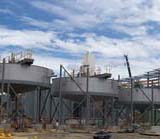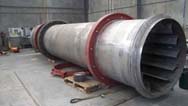Combining many of the beneficial properties of both ferritic and austenitic steels, 2205 is the most widely used duplex stainless steel grade. Its high chromium and molybdenum content gives the stainless steel excellent corrosion resistance. The microstructure provides resistance to stress corrosion cracking and ensures high strength.
The grade is generally not suitable for use at temperatures above 300oC or below -50oC because of reduced toughness outside this range.
You are most likely to encounter 2205 stainless steel being used in industrial environments such as petrochemical, chemical, oil, gas and paper plants.
 Alternative Grades
Alternative Grades
2205 has been available for several years - in general this complies with UNS grade designation S31803. More recently, product has become available complying with the higher corrosion resistant composition UNS S32205, as in table 1. Both these alternatives are known as 2205.
Composition
Grade 2205 has a micro structure of roughly equal amounts of ferrite and austenite, hence the 'duplex' description. The duplex structure of 2205 has the following properties:
- High strength.
- Lower thermal expansion co-effecient than austenitic steels but greater than carbon steels.
- High resistance to corrosion, particularly stress corrosion cracking, corrosion fatigue and erosion.
The high content of chromium and molybdenum and the addition of nitrogen gives the steel further beneficial characteristics:
- High general corrosion resistance.
- High pitting and crevice corrosion resistance.
- Good sulphide stress corrosion cracking resistance.
The addition of nitrogen gives a further increase in pitting and crevice corrosion resistance.
|
Table 1: Composition of 2205 and Alternative Grades (Single Values are Maximum) |
||||||||||
| Grade | Common Name | C% | Mn% | Si% | P% | S% | Cr% | Ni% | Mo% | N% |
| S31803 | 2205 | 0.030 | 2.00 | 1.00 | 0.030 | 0.020 | 21.0-23.0 | 4.5-6.5 | 2.5-3.5 | 0.08-0.20 |
| S32205 | 2205 | 0.030 | 2.00 | 1.00 | 0.030 | 0.020 | 22.0-23.0 | 4.5-6.5 | 3.0-3.5 | 0.14-0.20 |
Corrosion Resistance
The grade has excellent corrosion resistance and is superior to grade 316, performing well in most environments where standard austenitic grades may fail. 2205's low carbon content gives the grade a high resistance to intergranular corrosion and has better resistance to uniform, pitting and crevice corrosion due to its high chromium and molybdenum content.
As 2205 is a duplex stainless steel, the grade is also less sensitive to stress corrosion cracking in warm chloride environments, unlike austenitic stainless steels. The grade also has good resistance to stress corrosion cracking when exposed to hydrogen sulphide in chloride solutions.
High mechanical strength combined with excellent corrosion resistance gives 2205 high corrosion fatigue resistance.
 Heat Resistance
Heat Resistance
Although 2205 has good high temperature oxidation resistance, this grade, like other duplex stainless steels, suffers from embrittlement if held for even short times at temperatures above 300oC. If embrittled this can only be rectified by a full solution annealing treatment. 2205 is annealed at 1020-1100oC followed by rapid cooling. This treatment applies for both solution annealing and stress relieving.
Mechanical Properties
Mechanical properties for grade 2205 stainless steels are given in table 2.
|
Table 2: Mechanical Properties of 2205 (Annealed Condition) |
Table 3: Physical Properties of Grade 2205 (Typical Values in Annealed Condition) |
|||
| Tensile strength | 620MPa min | Density | 7,805kg/m3 | |
| Yield strength | 450MPa mi | Elastic modulus | 200GPa | |
| Elongation | 25% min |
Mean coefficient of thermal expansion |
||
| Brinell hardness | 293 HB max | 0-100oC | 13.7µm/m/oC | |
| Rockwell hardness | 31 HR C max | 0-315oC | ||
Physical Properties
Typical physical properties for grade 2205 stainless steels are given in table 3. There are surprisingly large variations in the values from different manufacturers for notionally identical materials.
2205 has a microstructure containing approximately 50% ferrite in the annealed condition, quenched from about 10500C. Higher annealing temperatures often result in an increase of ferrite content.
Fabricability
Due to the high yield strength of 2205, greater forces are required for the cold forming of this duplex steel, and will require larger capacity equipment than would be required for austenitic steels.
Processes such as stretch forming, deep-drawing and spinning are more difficult to perform.
Welding of 2205 is good by all standard methods, however, with the following restrictions:
- Do not pre-heat or post-heat the material, heat input must be kept low.
- Allow the material to cool between passes, preferably to below 150oC.
- Use correct filler grade 2209. Autogenous welding should be avoided.
Forms Available
Grade 2205 is available in hot rolled plate and strip, cold rolled sheet, plate and coil, forgings/bar, tube and pipe and in threaded fittings and flanges.
Applications
Grade 2205 is typically used in the construction of heat exchangers, pressure vessels, tanks, tubes and pipes for the following industry areas:
- Chemical processing, transport and storage.
- Oil and gas exploration and processing equipment.
- Marine and other high chloride environments.
- Pulp and paper digesters, liquor tanks and paper machines.
Specifications
For many products grade 2205 is covered by the same specifications that include the common austenitics - ASTM A240M for flat rolled and ASTM A276 for bar. Duplex grades of tube have their own specification - ASTM A789M and A790M covers duplex grades of pipe.
Credits
ASSDA would like to thank Peter Moore of Atlas Steels and Graham Sussex of ASSDA in the development of this article.